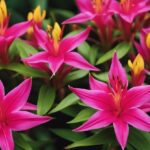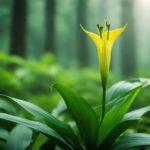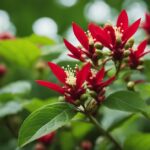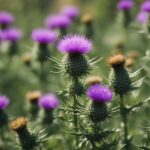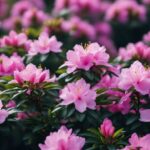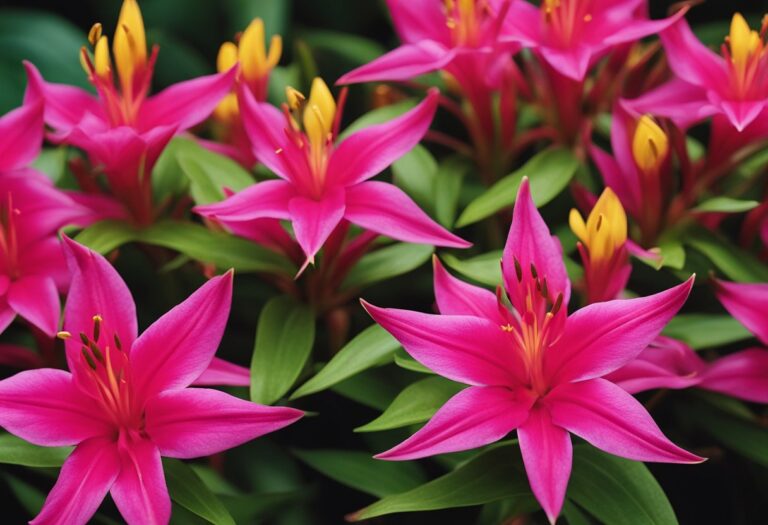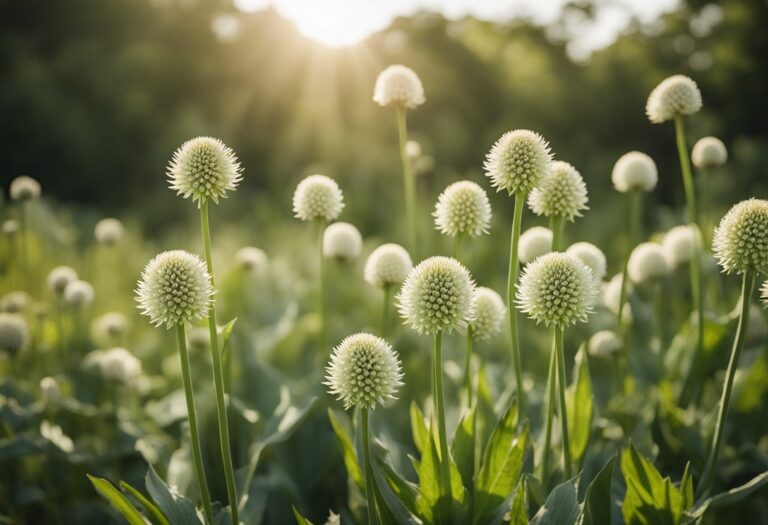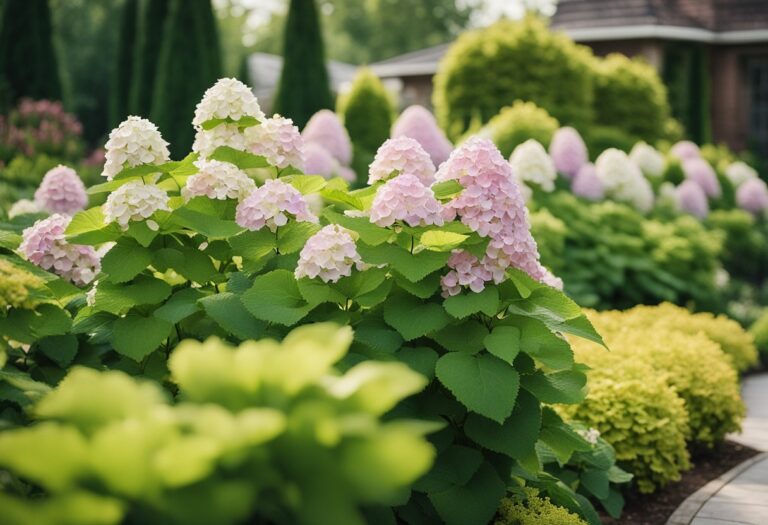Introduction to Oakleaf Hydrangea
The Oakleaf Hydrangea, known scientifically as Hydrangea quercifolia, is a standout among deciduous shrubs due to its distinctive foliage and attractive flowers.
Native to the southeastern United States, this plant offers an array of features that make it a worthy addition to your garden.
Characteristics:
- Foliage: Resembles oak tree leaves, with a deep green color that transitions to striking shades of red, orange, and burgundy in the fall.
- Flowers: Bears long-lasting, cone-shaped flower clusters that bloom in late spring to early summer.
- Size: Generally grows between 4 to 8 feet in height and width, although some varieties can reach up to 10 feet.
You will find that this hydrangea thrives in USDA Zones 5 to 9, showcasing resilience through various climates.
Its unique leaf shape is not only aesthetically pleasing but also functional, providing a lush backdrop for the delicate blooms.
Cultivation Tips:
- Sunlight: Prefers partial shade but can tolerate some morning sun.
- Soil: Does best in well-drained soil, with some moisture retention capabilities.
- Spacing: Plant 4 to 8 feet apart, depending on the variety, to ensure adequate air circulation.
When planting Oakleaf Hydrangea, dig a hole that is slightly deeper than the root ball and two to three times wider.
Upon planting, give your hydrangea sufficient water and maintain even moisture as it establishes itself.
Cultivation and Care
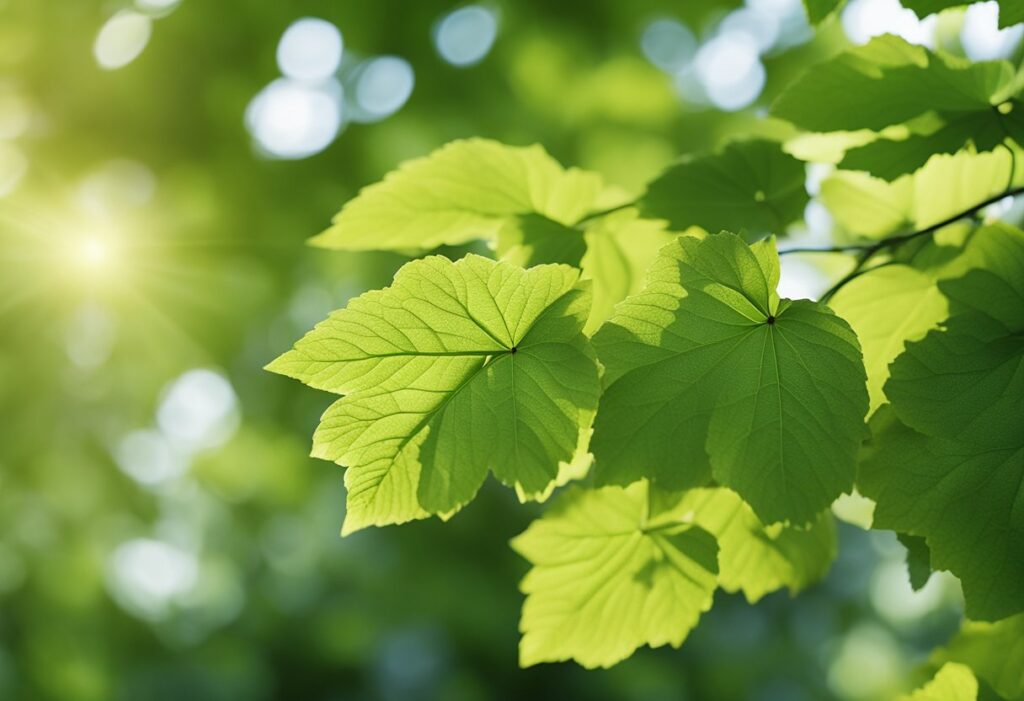
Achieving a healthy Oakleaf Hydrangea requires attention to planting location, consistent watering and fertilization, regular pruning, and vigilance against pests and diseases.
Planting
Choose a location that offers partial shade and accommodates the full mature size of your Oakleaf Hydrangea, which varies based on variety.
Plant in fertile, well-draining soil with a pH of 6.0 to 7.5.
Dig a hole that is slightly deeper than the root ball and about 2-3 times wider.
Space plants 4-8 feet apart, ensuring ample room for growth.
Watering and Nutrition
Oakleaf Hydrangeas thrive in moist soil, but it’s crucial to avoid waterlogging.
Provide regular irrigation, especially during dry spells, ensuring the soil is moist but not soggy.
Fertilize in early spring with a balanced, slow-release fertilizer to encourage strong growth and flowering.
Pruning
Pruning is best done in late winter or early spring before new growth appears.
Remove dead branches and thin the plant to encourage airflow. Trim back any errant or crossing branches to maintain a pleasing shape.
Pest and Disease Management
Inspect your plants regularly for signs of pests or disease.
Remove fallen leaves to prevent fungal diseases and ensure good air circulation.
If pests or diseases appear, treat them promptly with appropriate remedies, respecting both the plant’s health and environmental safety.
Landscape Uses
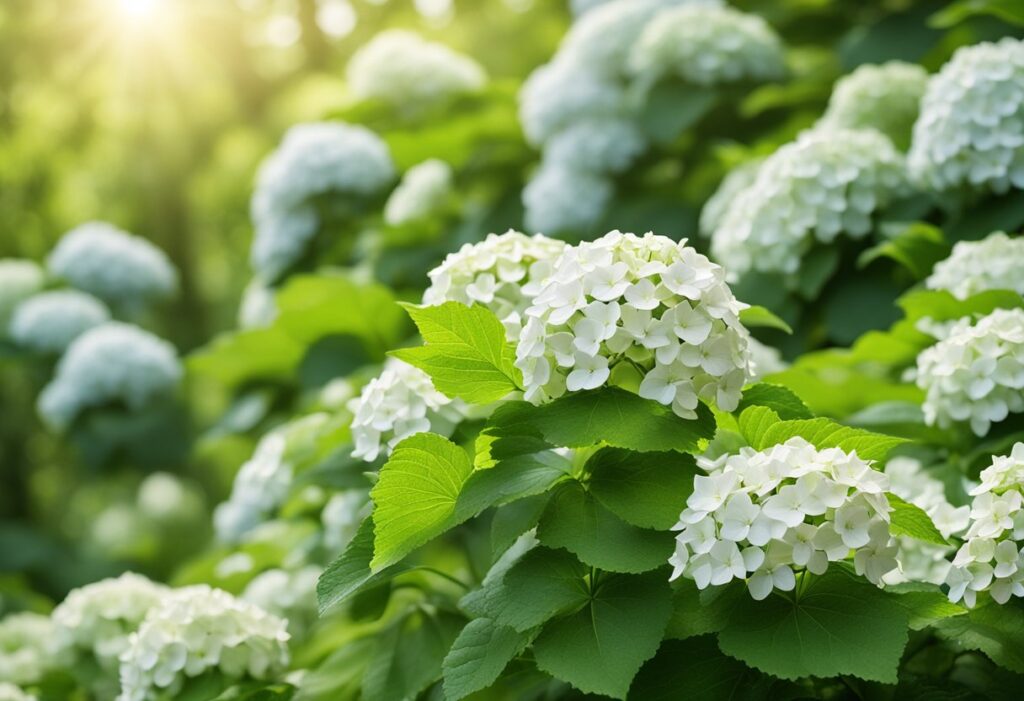
The Oakleaf Hydrangea offers versatile landscape applications. Its striking blooms and unique foliage make it a standout among garden plants.
As a Foundation Plant: Pair Oakleaf Hydrangeas with plants that flower at different times to ensure year-round interest.
For a balanced look, you could do well by placing them behind lower-growing evergreens or alongside other perennials.
Design Highlights:
- Borders: Use these shrubs as part of a mixed border for seasonal color and texture.
- Specimen Plant: An Oakleaf Hydrangea can serve as a focal point when planted individually due to its showy flowers and distinctive, lobed leaves.
In Containers: If you have limited space or non-ideal soil conditions, consider growing a smaller variety in a large container.
This allows you to enjoy the beautiful flowers and foliage up close, such as by an entryway or patio.
Considerations for Optimal Display:
- Lighting: Ensure they receive partial to full sun.
- Spacing: Give them room to spread, as this promotes healthy growth and air circulation.
Seasonal Interest: With leaves that transform from green to rich shades of red and purple in the fall, Oakleaf Hydrangea provides interest throughout the year. The peeling bark becomes a textural highlight in the winter months.
Varieties of Oakleaf Hydrangea
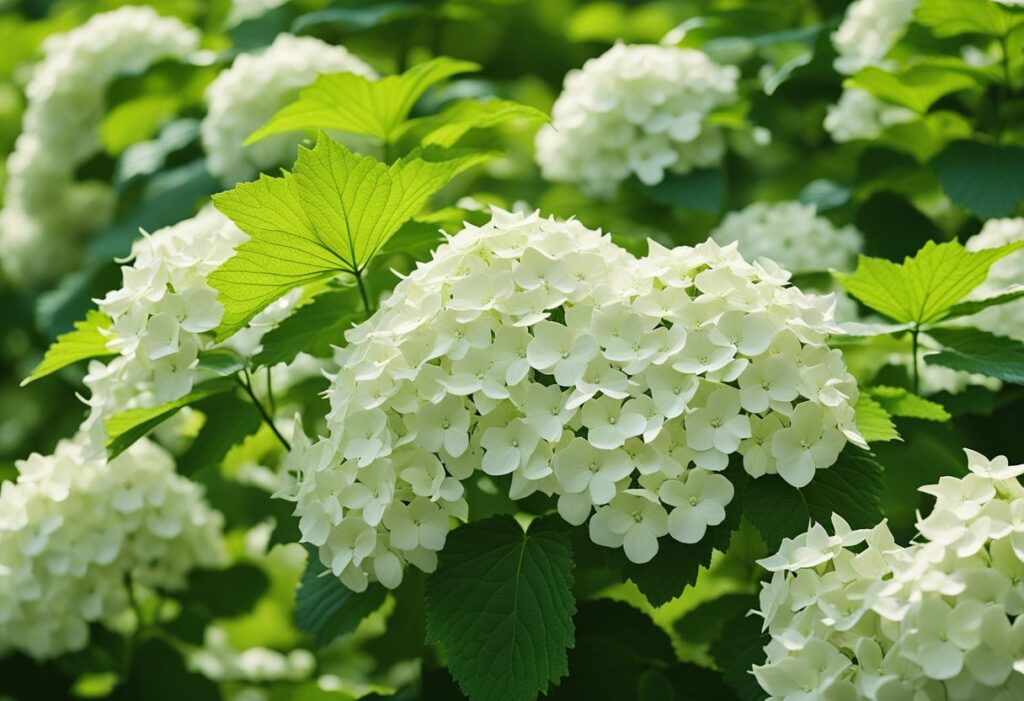
Oakleaf Hydrangea (Hydrangea quercifolia) is a standout for its unique foliage and showy flowers. This shrub is adaptable to a range of climates, primarily thriving in USDA Hardiness Zones 5 through 9.
You’ll discover that these plants offer diversity in size and color, fitting various landscape needs.
Small Varieties
- ‘Little Honey’: This dwarf cultivar is recognized for its bright yellow to chartreuse leaves and elongated, white panicles that transition to pink.
- ‘Sikes Dwarf’: Apt for smaller gardens, it reaches 2-4 feet in height and 3-4 feet in width with an open, rounded habit.
Noteworthy Varieties
- ‘Amethyst’: Renowned for its striking, deep purple to bronze fall coloration and elongated flower clusters.
- D. Sikes Dwarf: It maintains a compact form, making it ideal for limited spaces.
Planting Tips
When planting your Oakleaf Hydrangea, space them 4-8 feet apart depending on the mature size of the variety you’ve chosen.
Position them where they receive at least four hours of morning sun, although afternoon shade is beneficial in warmer climates to prevent scorching.
Table: Example Varieties of Oakleaf Hydrangea and Their Features
| Variety | Height & Width | Notable Features |
|---|---|---|
| Little Honey | 3-5′ x 4-5′ | Yellow-chartreuse leaves, white-pink flowers |
| Sikes Dwarf | 2-4′ x 3-4′ | Compact, good for small spaces |
| Amethyst | 4-6′ x 4-6′ | Purple-bronze fall color, elongated flowers |
| D. Sikes Dwarf | 2-3′ x 3-4′ | Rounded, open habit, suitable for limited space |
Remember to keep the soil moist and well-drained when caring for these varieties, as Oakleaf Hydrangeas prefer consistent moisture without being waterlogged.
With proper care, they’ll reward you with stunning seasonal interest and versatility in your garden.
Propagation Methods
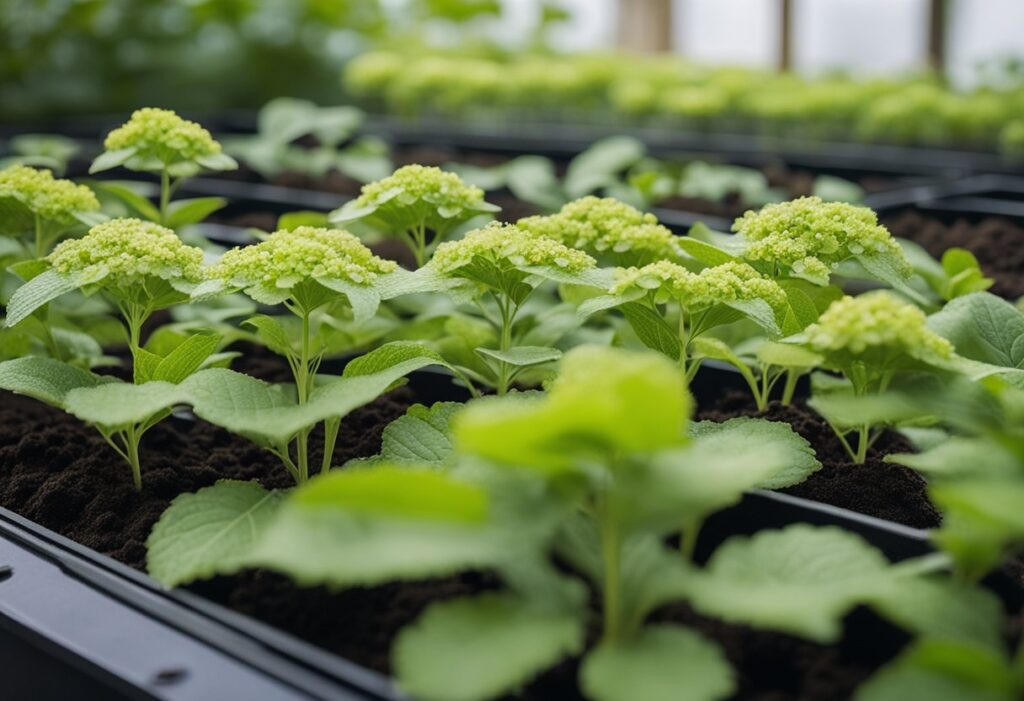
To successfully propagate your Oakleaf Hydrangea, you can employ several techniques including stem cuttings, division, and layering. Each method suits different levels of gardening experience and seasons.
Stem Cuttings: This is a popular method performed in early summer, using new growth.
- Select and Prepare Cuttings:
- Choose healthy 4-6 inch stems.
- Cut below a node (where leaves attach).
- Remove leaves near the base to prevent rot.
- Rooting:
- Dip the end in the rooting hormone.
- Insert into a moist potting mix.
- Keep the soil moist and wait for root development.
Division: This approach is best in early spring or fall and is ideal for mature plants.
- Dig and Separate:
- Carefully unearth the root ball.
- Use your hands or shears to divide, ensuring each has roots and shoots.
- Planting:
- Space out sections at least 18 inches apart in prepared holes.
- Water consistently to establish the new divisions.
Layering: This method involves minimal disturbance to the parent plant and can be done in spring or early summer.
- Preparation:
- Bend a low-lying branch to the ground.
- Nick branches the underside and applies the rooting hormone.
- Rooting:
- Secure the branch in the soil with a peg.
- Cover with soil, leaving the tip exposed.
- Roots will form at the contact point; sever from the main plant when established.
For best results, perform propagation on a cloudy day to reduce transplant stress and ensure consistent moisture until roots are well-formed.
Frequently Asked Questions
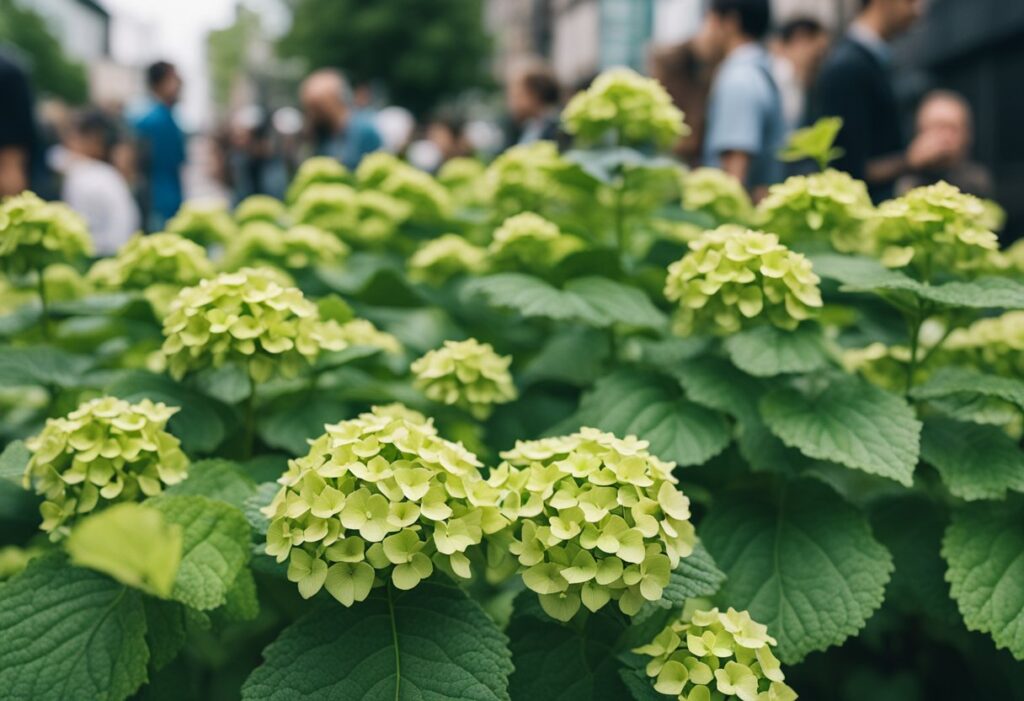
In this section, you’ll find targeted answers to common questions about oakleaf hydrangeas, helping you understand how to care for them effectively, recognize their unique features, and ensure they thrive in your garden.
How do I manage common problems faced by oakleaf hydrangeas?
To manage common issues like leaf disease, ensure good air circulation by removing fallen leaves and providing adequate space between plants.
Protect flower buds from cold damage by situating your hydrangea in a sheltered location.
What are the distinguishing characteristics of oakleaf hydrangea flowers?
Oakleaf hydrangea flowers are notable for their conical shape and the way they transform in color, often starting white and gradually changing to deep pink as they age.
What are the mature size dimensions for an oakleaf hydrangea?
Mature oakleaf hydrangeas typically range from 5 to 8 feet in height and width, but this varies with the specific variety.
How do dwarf oakleaf hydrangea varieties differ from standard ones?
Dwarf oakleaf hydrangeas are bred for more compact growth. For example, the ‘Jetstream’ variety usually achieves a size of around 5 feet tall and wide, unlike their larger counterparts.
What conditions are preferred for the optimum growth of oakleaf hydrangeas?
Oakleaf hydrangeas thrive in rich, well-draining soil with a slightly acidic pH of 5.5 to 6.5. They also perform best in areas with full sun to partial shade.
When is the ideal time of year for planting oakleaf hydrangeas?
The best time to plant oakleaf hydrangeas is either in the spring after the last frost or in the fall before the ground freezes. The timing depends on your local climate.


